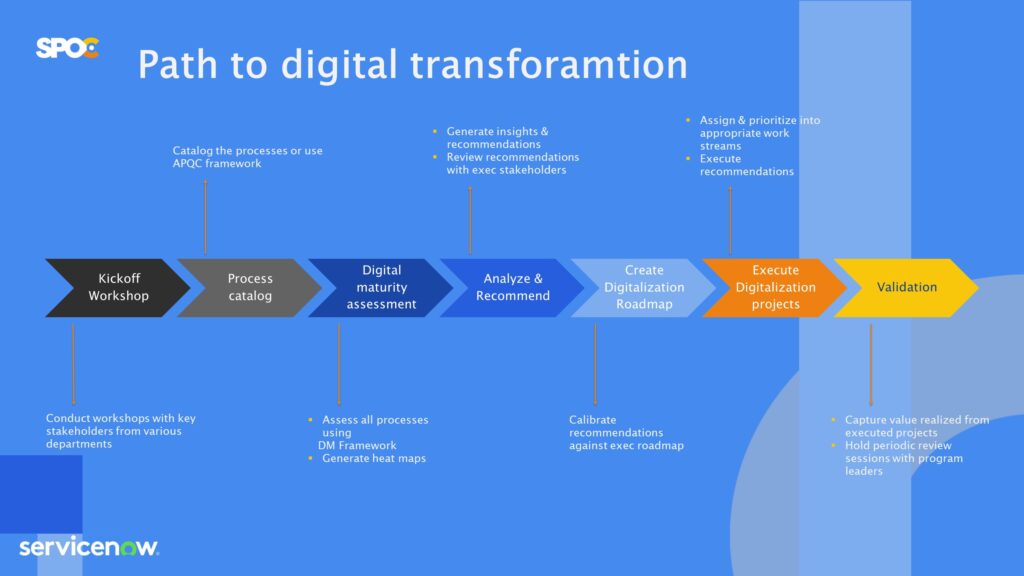So you have completed your Digital Maturity Assessment for your ServiceNow platform. That is great! However, did you know that 7 in 10 clients (based on our observations) stop at this stage? Perhaps it’s because they don’t know what to do next or don’t have the necessary resources to take action. To fully benefit from your DMA and achieve better ROI, the next crucial step in your digital transformation journey is building a Roadmap. But why is it necessary, and what exactly does it entail? Let’s dive into it.

Digital Maturity Assessment as a starting point for a ServiceNow platform ROI
You’ve evaluated your company’s proficiency in utilizing digital technologies to support its business objectives. Now you understand how your company is currently using the ServiceNow platform. Thanks to DMA, you identified opportunities for improvement that will enable you to leverage your solutions to drive business value in a better way.

Building a ServiceNow roadmap is about more than just implementing technology – it’s about creating a strategic plan that aligns ITSM processes with business objectives. By weaving together the threads of systems, departments, processes and strategies, a ServiceNow roadmap becomes the roadmap for success.
Adam Bernaś, Chief Technology Officer, CMA

The creation of a Roadmap ensures that your organization focuses on the key areas that require improvement, specifically in ITSM systems, and enables a strategic approach to technology implementation. By aligning business objectives with digital capabilities, the Roadmap becomes an essential tool for achieving success in digital transformation. It provides a clear vision of the steps needed to close gaps and seize opportunities, allowing for streamlined and efficient implementation of technology solutions. In essence, the Roadmap is the crucial link between the DMA’s insights and the realization of your organization’s digital goals.

Roadmapping in ServiceNow enables businesses to design and plan productive digital IT workflows that align with their overall objectives. With the latest Now Platform release and support for next-generation technologies, ServiceNow provides professional planning and design capabilities to help businesses stay ahead of the curve.
Adam Bernas, Chief Product Officer, CMA
What is a Roadmap, and what is not?
Simply put, a Roadmap is a strategic plan that outlines the path to achieving your goals within ITSM implementation. In the context of your ServiceNow platform strategy, a Roadmap will help you prioritize your initiatives, identify dependencies, and allocate resources effectively. It will also provide a clear and concise view of your organization’s digital transformation journey and help you communicate it to stakeholders.

Roadmaps are surely not solution-oriented. It is not giving you answers on how to do it, but rather what are your general goals, destinations, and phases to achieve that ultimate goal which would be a successful ServiceNow implementation and high ROI.
Without a Roadmap, your company risks stagnating and falling behind in the ever-evolving digital landscape. You may continue facing the same inefficiencies, limitations, and challenges the DMA highlighted. By not taking action and building a Roadmap, you miss out on the opportunities for growth, optimization, and innovation that the ServiceNow platform provides to businesses.
How to build ServiceNow Roadmaps?
Building Roadmaps involves several key steps. First, you need to define your vision and objectives. What are your long-term goals, and how will your ServiceNow platform help you achieve them? Next, you’ll need to assess your current state and identify gaps. What areas of your platform are functioning well, and what needs improvement? Based on this assessment, you can prioritize your initiatives and develop roadmaps with a timeline for implementation.
Remember that it is not a stiff set of rules but a living document that should be updated regularly to reflect changes in your organization’s priorities and capabilities. By continually assessing your progress and adjusting your Roadmap as needed, you’ll be able to stay on track and ensure that your digital transformation journey is a success.
During the Roadmap building stage, your company will identify the high-level initiatives necessary to achieve its digital transformation goals. These initiatives may include process improvements, technology enhancements, and organizational changes. The Roadmap outlines each initiative’s timeline, resources, capabilities, and dependencies, allowing your organization to prioritize the efforts and allocate resources effectively.
Highway to Hell or Roadmap to ROI?
We have seen far too many companies that invested significant money in implementing the most expensive ITSM system on the market, treating it as the goal itself. It opened a “highway to hell” for these companies as they did not analyze, prepare or implement the platform in a systemic and well-thought-out way.
Adam Bernas, Chief Product Officer, CMA
The truth is that by following a Roadmap, companies can systematically address their digital transformation goals and track their progress. They can identify and mitigate risks, adjust their priorities as needed, and ensure alignment with their customers and overall business objectives.

Build Roadmap with us
As we previously discussed the importance of DMA here, we believe that taking the step afterwards is as crucial to the successful implementation. Your company needs to build a Roadmap to implement your DMA findings and achieve digital transformation goals.
Without a Roadmap, you risk losing out on the opportunities and benefits the ServiceNow platform can provide your business. As we constantly help our clients build such Roadmaps, do not hesitate to contact our specialists at SPOC.


